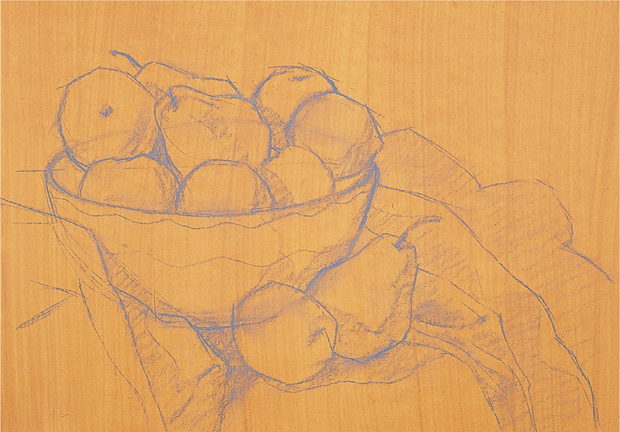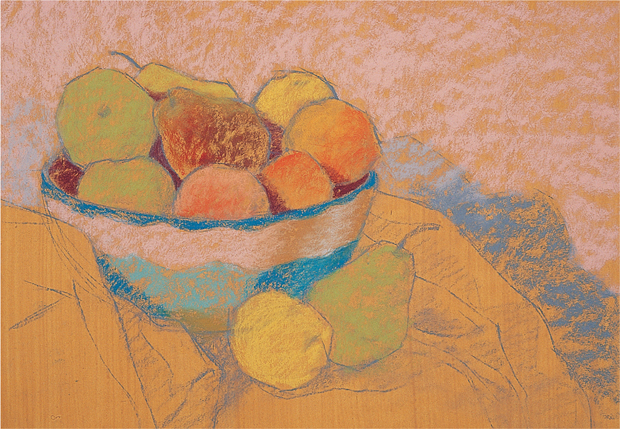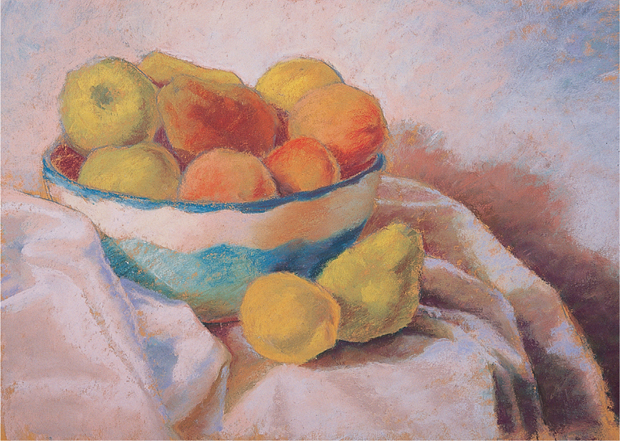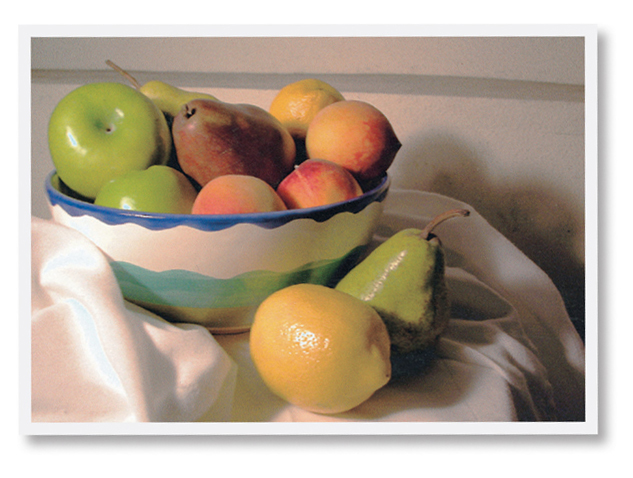PASTEL LESSON 1
Fruit Still Life with Marla Baggetta
With a vast number of hues to choose from and the ability to create a range of textures, pastel is an ideal medium for capturing the rich colors and lush textures of fruit. Fruit makes a great subject for still lifes, as it includes an organic and harmonious mix of shapes, colors, and sizes. When setting up a still life, create variety by arranging the elements on several different levels, overlapping the elements to avoid a stagnant composition. For this painting, artist Marla Baggetta tested a number of light sources and setups before choosing this slightly asymmetric arrangement of pears, lemons, peaches, and apples.

1 Start by using a flat paintbrush to tone the support with a wash of yellow ochre acrylic. For the initial drawing, use a cold deep gray hard pastel that will easily be covered by the subsequent layers of color. Draw the basic shapes of the bowl, the fruit, and the drape, paying particular attention to the ellipse of the bowl. Then outline some of the shadow shapes and the contours of the objects.

2 Quickly block in the basic shapes using the sides of hard pastels. Cover the background with shell pink; then paint the green apples with light sap green, the lemon with lemon yellow, and the peaches with layers of salmon pink and shell pink. Use light sap green for the green pears and a mix of sanguine and salmon pink for the red pear. For the stripes on the bowl, apply light turquoise blue in the light areas and peacock blue in the dark areas. Use warm medium gray for the shadow on the wall. Then add some dark values in between the fruits and on the shadows with carmine.

3 Next block in the drape, using shell pink for the light areas, light blue for the shadows on the drape and the wall, and warm medium gray for the shadows on the fruit. Use the length of the pastel sticks to apply color, but don’t press very hard; allow the texture and the color of the toned paper to show through.
4 Now switch to soft pastel for the next stage of the painting. When adding the core shadow (the darkest part of the form shadow—the shadow on the surface of the object itself) to each piece of fruit, its reflected light—the light bouncing off another object onto this one—also is revealed. Use fern green for the lemon’s core shadow, and switch to viridian green for the green pear’s core and cast shadows (those that are thrown onto another surface).

5 Once you have the forms of each element worked out, begin to focus on the nuances of color and value. Add some light sap green to the top of the red pear. Then layer the background with light Naples yellow in the center, adding light turquoise blue and warm light gray as you work toward the edges. Here you’re actually blending by layering, so don’t use your finger to blend at all. Next darken the cast shadows against the wall with burnt umber.

6 Now make some final adjustments to the drape, using a bit of white for the high-lights, blending some areas with your finger to soften the transitions. Apply yellow ochre to the center of the bowl, and add some highlights to the fruit with a mixture of white and light Naples yellow. Also make sure that the highlights on the shiny fruits are more defined than the highlights on the surface of the fuzzy peaches. Create the stems to the fruit with nut brown, and then add burnt umber on the shadowed side of each stem. Finally, blend the background a bit with your finger to smooth out the strokes. Once you’re sure that there aren’t any more adjustments you wish to make, your painting is complete.


